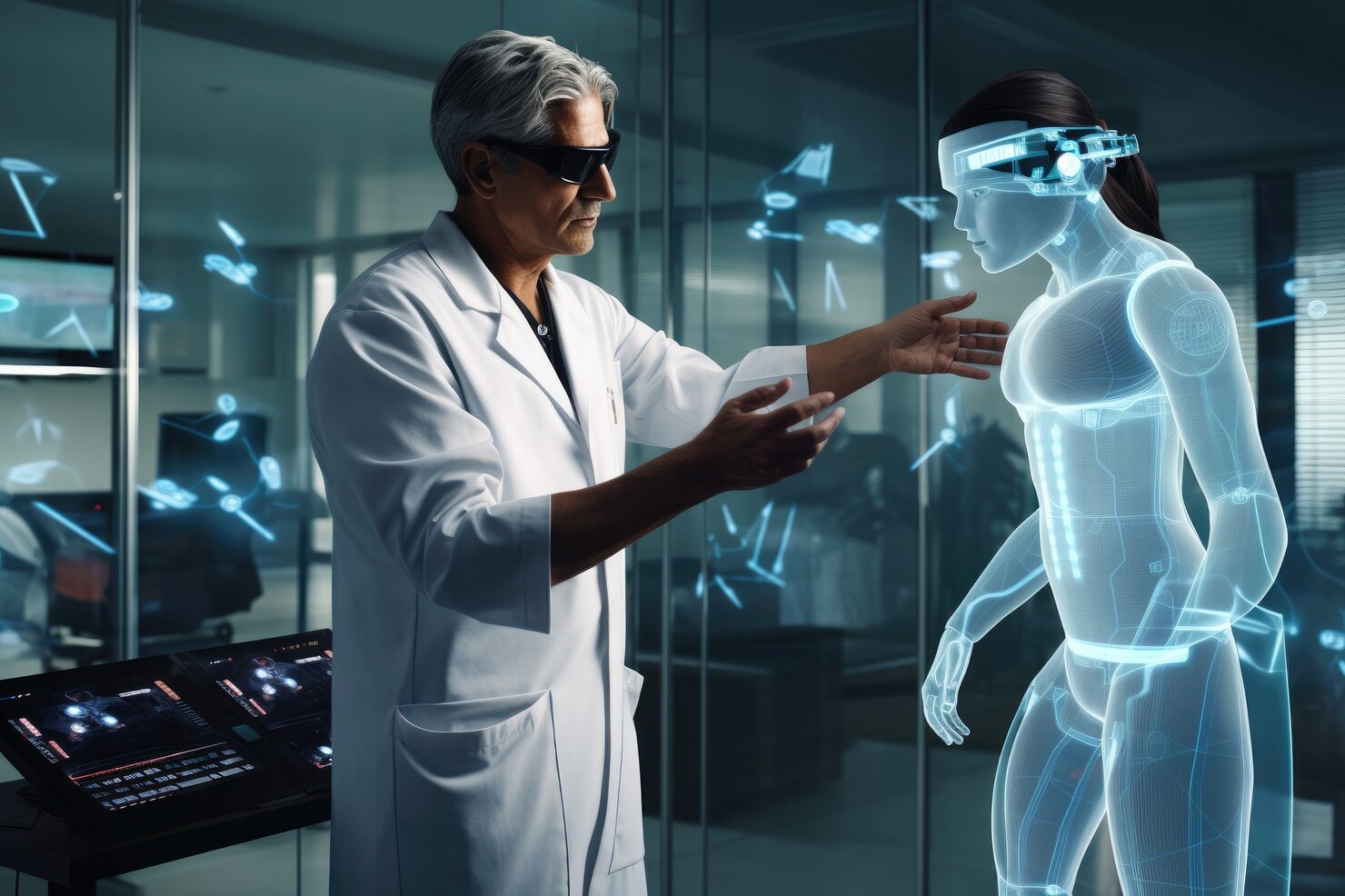
Augmented reality, or AR, has become a breakthrough technology in the fast-paced field of healthcare, providing fresh approaches to better patient care. Patient anatomy visualization is one such important use of AR in healthcare. This innovative technology is improving diagnosis, treatment planning, and patient education by altering how medical professionals see, comprehend, and communicate complicated anatomical information.
Surgeons can now operate more safely and accurately thanks to AR. Furthermore, it makes it possible to record and replicate live processes for educational purposes. AR integrates AI with one or more senses to perform surgical tasks more efficiently.
The AR market in healthcare is projected to grow at a CAGR of 21% from 2023 to 2032, showing huge potential.
This blog explores the transformative impact of AR in medicine, focusing on its ability to navigate the intricate complexities of the human body through interactive anatomy.
The Power of Augmented Reality in Healthcare
By fusing the virtual and physical worlds seamlessly, augmented reality offers a dynamic and immersive experience. AR has several benefits when it comes to visualizing a patient’s anatomy, which helps to provide more precise and customized medical care. Let’s explore them one by one.
Enhanced Visualization for Diagnosis: Diving Deep
The most significant advancements in diagnostic imaging over the past ten years have been in magnetic resonance imaging, computed tomography, mammography, and ultrasound. Before the incision, almost all surgeries require some sort of scan.
The older generation of imaging displays still exists, even though the imaging process has fundamentally changed. To comprehend the patient’s condition in this scenario, the surgeon has to pay close attention to combining various images, like CTs and angiograms, into their unique context. The main benefits of AR in this regard include:
- Allowing healthcare professionals to visualize patient anatomy in three dimensions, providing a more comprehensive and detailed understanding of the internal structures.
- Displaying images and other data about patients could save many human errors and lives by reducing medical errors.
- Providing access to simultaneous patient data to the entire team working in the operating room leading to viewing and work discrepancies, eliminating communication gaps.
For instance, AR has been found to provide intraoperative support during pedicle screwing.
According to a study published in “The Spine”, in a cadaveric model, AR-placed lumbar pedicle screws showed an improved comparative accuracy to that of fluoroscopy-guided screw placement, with reproducible accuracy across studies in both open and minimally invasive approaches.
Another example is that by using AR, medical professionals get better at drawing blood, using a handheld scanner that projects over the skin and shows nurses and doctors where veins are in the patients’ bodies.
Precision in Surgical Planning: Multi-tasking without Errors
Imagine a difficult surgery that needs a specialist’s experience and quick attention!
With AR, doctors can overlay digital representations of a patient’s anatomy on the operating field, leading them to plan and carry out surgeries with unmatched precision, reducing risks and enhancing surgical outcomes overall. As AR uses aggregated data from multiple scans (MRI, CT, and ultrasound), unexpected outcomes can be reduced during surgery.
Furthermore, a robotic arm surgeon can use AR to perform surgery remotely. The surgeon uses sensory input in addition to the camera in this scenario, helping surgeons see more clearly and precisely inside the affected area (such as the knee joints, eyes, heart, etc.) before beginning any procedure.
For instance, AR software created by Sync allows surgeons to see through surgical instruments directly through digitally enhanced images, known as “X-ray vision.”
Interactive Learning and Training: Aiding Medical Education
Applications for AR have a big impact on medical education. In a hands-on and immersive way, students can work with interactive anatomy models, dissect virtual cadavers, and investigate minute details.
This allows for a thorough understanding of the human body thanks to 3D modeling as students can be taught using scenarios that closely mimic real-world surgical settings. This guarantees that:
- Students can use the model created by recording real-time procedures from various perspectives to mimic surgery in virtual reality.
- Surgery abilities can be improved greatly and effectively through simulation-based AR training.
- Overall expenses, recuperation time, and postoperative complications can be lowered.
Case Western Reserve University and the Cleveland Clinic have partnered with Microsoft to release a HoloLens app called HoloAnatomy to visualize the human body in an easy and spectacular way.
This has revolutionized medical education, as students can see the human body in 3D instead of the usual working method: black-and-white pictures and written descriptions in books.
Challenges in the Way
Despite being a technological innovation, AR technology is still in its infancy and comes with its challenges that include –
Potential Technical and Physical Issues
Healthcare clinics are still apprehensive about incorporating AR into their regular operations. This is caused in part by the limitations of the hospital’s current computer system as well as the relative youth of technology. Low-contrast images and other issues could also arise with the content and images that AR provides, such as incorrect anatomy placement or depth displays.
Regulatory Constraints
There is a comprehensive set of rules, regulations, and insurance regulations that must be followed when using AR devices and apps. The ethical issues of informed consent and patient privacy should also be taken into account.
Data Security
Cyberattacks are a possibility with AR technology, just like with any other type. Hackers target AR devices and software because of the vast amount of sensitive data they collect. However, this can be avoided with an appropriate security management system.
Summing it Up
Augmented reality (AR) is superimposing digital information or entities on real-world screen-captured videos (recorded, or live-streamed).
AR has diverse applications, from cutting costs to optimizing conversions & revenue generation, efficient collaboration, enhanced omnichannel experiences, better learning, and improved connectivity. There are endless use cases of AR for healthcare. How do you wish to utilize it?
Codewave’s approach to developing AR applications is centered around diving deep into need identification, understanding industry dynamics, and developing solutions accordingly to improve augment value delivery, and scale at will or on a need basis.
Codewave EIT’s AR services for you include:
– Strategy, design, prototype, and development services for architecting an enhanced immersive realism
– Reimagine CX with immersive solutions built for multisensorial engagement
– Design enterprise-ready, ergonomic solutions for the AR-enabled HMDs
– Build AR effects/filters/capabilities for social platforms & your camera apps
– Gamified AR apps development
– Simulated training, collaboration, and immersive learning app development
– AR-led remote field services solutions development
– End-to-end AR consultation & development
If you want to stay updated in the realm of AR-driven healthcare advancements, you can always talk to our consultants. Explore our range of solutions to make the healthcare future bigger and better.
